
The Peugeot 205 is a supermini (B-segment) car produced by the French manufacturer Peugeot from 1983 to 1999.

The Metro is a supermini car, later a city car that was produced from 1980 to 1998, first by British Leyland (BL) and later by the Rover Group. It was launched in 1980 as the Austin Mini Metro. It was intended to complement and eventually replace the Mini, and was developed under the codename LC8. The Metro was named by What Car? magazine as "Car of The Year" in 1983 as an MG, and again as the Rover Metro in 1991.

The SEAT León, also spelled Leon in some other languages, is a small family car built by the Spanish car manufacturer SEAT since October 1999.

The Audi A6 is an executive car made by the German company Audi since 1994. Now in its fifth generation, the successor to the Audi 100 is manufactured in Neckarsulm, Germany, and is available in saloon and estate configurations, the latter marketed by Audi as the Avant. Audi's internal numbering treats the A6 as a continuation of the Audi 100 lineage, with the initial A6 designated as a member of the C4-series, followed by the C5, C6, C7, and the C8. The related Audi A7 is essentially a Sportback (liftback) version of the C7-series and C8-series A6 but is marketed under its own separate identity and model designation.

The Audi 80 is a compact executive car produced by the Audi subdivision of the Volkswagen Group across four generations from 1966 to 1996. It shared its platform with the Volkswagen Passat from 1973 to 1986 and was available as a saloon, and station wagon — the latter marketed by Audi as the Avant. The coupé and convertible models were not badged as members of the range, but used a derivative of the same platforms.
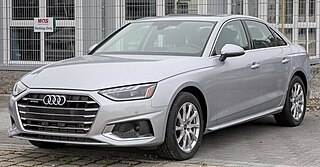
The Audi A4 is a line of luxury compact executive cars produced since 1994 by the German car manufacturer Audi, a subsidiary of the Volkswagen Group. The A4 has been built in five generations and is based on the Volkswagen Group B platform. The first generation A4 succeeded the Audi 80. The automaker's internal numbering treats the A4 as a continuation of the Audi 80 lineage, with the initial A4 designated as the B5-series, followed by the B6, B7, B8, and the B9.

The Škoda Superb is a mid-size/large family car (D-segment) that has been produced by the Czech car manufacturer Škoda Auto since 2001.
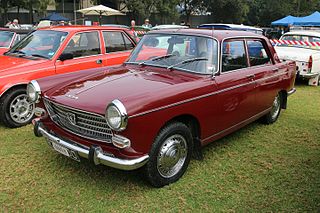
The Peugeot 404 is a large family car produced by French automobile manufacturer Peugeot from 1960 to 1975. A truck body style variant was marketed until 1988. Styled by Pininfarina, the 404 was offered initially as a saloon, estate, and pickup. A convertible was added in 1962, and a coupé in 1963. The 404 was fitted with a 1.6 litre petrol engine, with either a Solex carburetor or Kugelfischer mechanical fuel injection or a 1.9 litre diesel engine available as options. Introduced at the Paris Motor Show as an option was the inclusion of a 3-speed ZF automatic transmission, similar to the unit already offered on certain BMW models, as an alternative to the standard column-mounted manual unit.

The Peugeot 305 is a medium-sized car produced by the French automaker Peugeot from 1977 to 1989. It was offered as a four-door saloon, five-door estate, and as a three-door van derivative.

The Peugeot 207 is a supermini car (B) that was designed and produced by the French automaker Peugeot from 2006 to 2014. It was presented at the Geneva Motor Show in 2006, and entered production in April 2006, as the successor to the Peugeot 206. It shares the same platform with the Citroën C3.
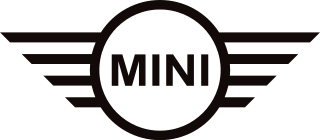
Mini is a British automotive brand founded in Oxford in 1969, owned by German Multinational automotive company BMW since 2000, and used by them for a range of small cars assembled in the United Kingdom, Austria, Netherlands and Germany. The word Mini has been used in car model names since 1959, and in 1969 it became a brand in its own right when the name "Mini" replaced the separate "Austin Mini" and "Morris Mini" car model names. BMW acquired the brand in 1994 when it bought Rover Group, which owned Mini, among other brands.

The Škoda Roomster is a small family car manufactured and marketed by Škoda Auto from 2006 to 2015 over a single generation with a single intermediate facelift. It has a five-door, five passenger, front-engine, front-wheel drive, high-roof design and has been described as a hatchback, an estate car, or a multi-purpose vehicle. Styled by Thomas Ingenlath and Peter Wouda, the Roomster premiered at the 2006 Geneva Motor Show) as the first car marketed after Volkswagen Group's takeover of Skoda, sharing the A4 (PQ34) platform and components with the second generation Škoda Fabia.
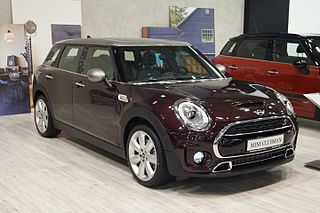
The Mini Clubman is a subcompact executive car engineered and manufactured by German automaker BMW and sold under the Mini marque. The first-generation Clubman was introduced in 2007, as a variant of the Mini Hatch. A commercial version called Clubvan was added to the range in 2012. The current second-generation model has been in production since 2015 and available with front- and all-wheel drive.
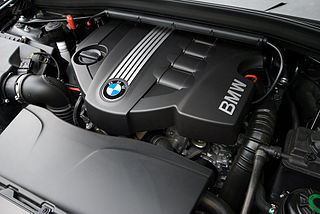
BMW N47 is a four-cylinder common rail diesel engine that has many improvements over its predecessor, the M47. In 2014 it was replaced with the B47. The USA market never received B47 engine. The only B engine in the US for a diesel was a B57 in 2018 540d. The newest 4 cylinder diesel in the US was N47TU.

The Mini Countryman, also called Mini Crossover in Japan, is a subcompact crossover SUV, the first vehicle of this type to be launched by BMW under the Mini marque. It was launched in 2010 and received a facelift in 2014. The second generation vehicle was released in 2017.
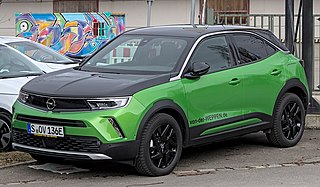
The Opel Mokka is a subcompact crossover SUV that has been produced by German automaker Opel since 2012. Sales began with the model year of 2013, at the end of 2012. The first generation was developed by GM Korea as the U200 Chevrolet Trax. The facelifted Opel Mokka was marketed as the Mokka X, before reverting to Mokka for the second generation. It is also sold under the Vauxhall brand in the United Kingdom. The Buick Encore sold in North America and in China was also derived from the Trax but the lines diverged after Opel became part of Stellantis.

The Mini Hatch, stylised as MINI Hatch, also sold as Mini Cooper, Mini One, or simply called the BMW Mini, are a family of retro-styled two-door supermini hatchback and convertible; and a longer, subcompact 4/5-door hatchback. They were introduced in July 2001 by German automaker BMW under the 'Mini' brand. The second generation was launched in 2006 and the third, adding a longer 4/5-door hatchback, in 2014. A two-door convertible version was added in 2004, followed by its second generation in 2008. With the launch of the fourth generation in 2024, the Mini Hatch has been renamed to Mini Cooper.

The Mini Coupé and Mini Roadster are two-seater sports cars that were engineered and manufactured by German automaker BMW under the Mini marque between 2011 and 2015.
The BMW B38 is a 1.2 and 1.5 L turbocharged straight-three DOHC petrol engine, which replaced the straight-four BMW N13. Production started in 2013.

The BMW B48 is a turbocharged inline-four petrol engine which replaced the BMW N20 and has been in production since 2014. It was first used in the F56 Mini Hatch and has been used in BMW applications since 2015.






















